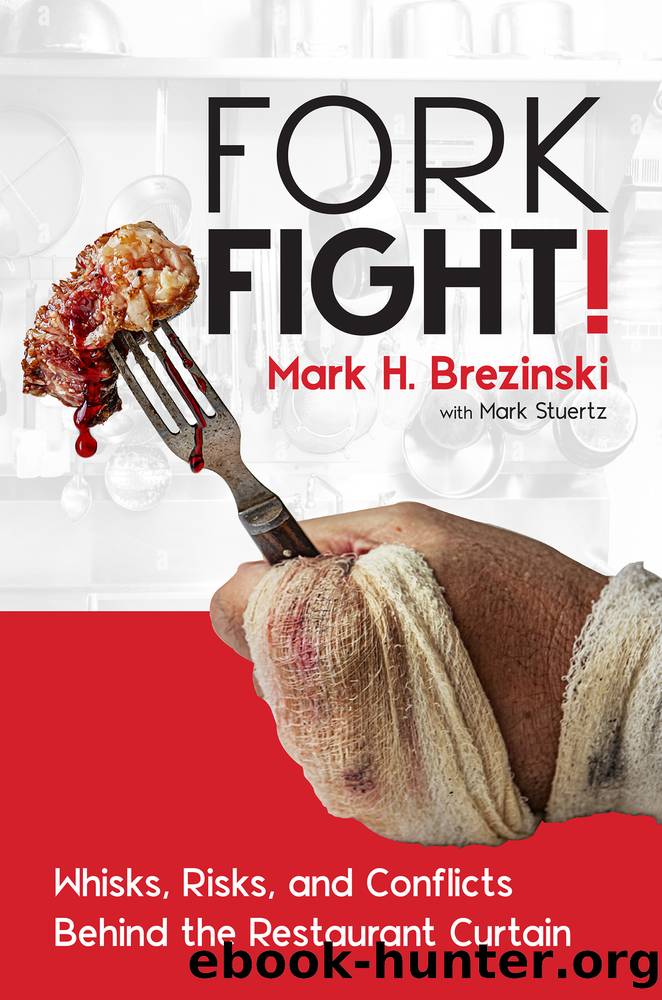ForkFight!: Whisks, Risks, and Conflicts Behind the Restaurant Curtain by Mark H. Brezinski

Author:Mark H. Brezinski [Brezinski, Mark H.]
Language: eng
Format: epub
ISBN: 9781637587515
Publisher: Post Hill Press
Published: 2023-01-21T07:32:09+00:00
10
Trinity Groves. How I Survived Phil Romano. Again
By any definition, Uno Immanivong was a head-turner. As she walked towards our makeshift offices on Broadway Avenue in the rough West Dallas neighborhood, she cut a figure that vivified the eyes. She had long black hair that spilled elegantly over her shoulders, and she wore a tight shirt and a pair of orange slacks that fit as if they had been sprayed on. Her smile beamed from fifty yards away. She was tallâeven taller in fashionable Manolo Blahniksâand impossible to look away from.
This was a banker? I asked myself. I was introduced to Uno by fellow restaurateur Mico Rodriguez, an icon in the Dallas restaurant community, whose successes included the powerful Mi Cocina restaurant group. Mico had met Uno through the business and suggested that if I gave her a bit of my time, I wouldnât be disappointed. Her pedigree was exotic. Born in a refugee camp in Thailand after her parents fled Laos, she became a regional sales and support consultant for Wells Fargo Home Mortgage before dabbling in the culinary arts. She had a chefâs heart and an entrepreneurial spirit that had impressed Mico.
She dripped confidence as she held her hand out to shake well before I presented my own. If youâre pitching an idea to a group of investors and consultants, you probably couldnât have done better. And thatâs what Trinity Groves was all about: Show up, make a strong pitch, and see if you passed the sniff test and were invited to audition your idea for your first restaurant!
So what was Trinity Groves? Prior to the designation, the area was a destitute, unnamed tract of land west of Dallasâs thriving downtown. Years before, it was home to a lead smelter and a cement plant that later became a Superfund cleanup site. Low-income housing, industrial buildings, and a long-haul truck terminal dotted the several hundred-acre landscape. It was accessible for years by the Continental Bridge that linked the area to downtown.
Savvy investors, including my old restaurant buddy Phil Romano, had been buying up land in this area for years, just waiting for Dallas to quench its thirst for growth through westward expansion. It was not a place you would ever visit unless you were headed to Rayâs Hardware and Sporting Goods, a haven for gun enthusiasts.
That was before the city of Dallas had enlisted international Spanish architect Santiago Calatrava. Calatrava was to design a series of bridges over the Trinity River as part of the Trinity River Project, a plan aimed at turning the river basin into an ensemble of sports fields, trails, and a nature center and recreational park. One of those visually stunning bridges was to be erected directly next to the Continental Bridge that would be modified into a pedestrian thoroughfare named the Ronald Kirk Bridge.
Financed in part by Dallasâs uber-legendary Hunt oil family, the Calatrava bridge was named for heiress and philanthropist Margaret Hunt Hill. In the press and in conversation, the span was sarcastically dubbed âthe bridge to nowhere.
Download
This site does not store any files on its server. We only index and link to content provided by other sites. Please contact the content providers to delete copyright contents if any and email us, we'll remove relevant links or contents immediately.
Life 3.0: Being Human in the Age of Artificial Intelligence by Tegmark Max(5478)
The Sports Rules Book by Human Kinetics(4299)
The Age of Surveillance Capitalism by Shoshana Zuboff(4216)
ACT Math For Dummies by Zegarelli Mark(3996)
Unlabel: Selling You Without Selling Out by Marc Ecko(3591)
Blood, Sweat, and Pixels by Jason Schreier(3568)
Hidden Persuasion: 33 psychological influence techniques in advertising by Marc Andrews & Matthijs van Leeuwen & Rick van Baaren(3476)
The Pixar Touch by David A. Price(3369)
Bad Pharma by Ben Goldacre(3358)
Urban Outlaw by Magnus Walker(3342)
Project Animal Farm: An Accidental Journey into the Secret World of Farming and the Truth About Our Food by Sonia Faruqi(3178)
Kitchen confidential by Anthony Bourdain(3016)
Brotopia by Emily Chang(3002)
Slugfest by Reed Tucker(2945)
The Content Trap by Bharat Anand(2863)
The Airbnb Story by Leigh Gallagher(2800)
Coffee for One by KJ Fallon(2571)
Smuggler's Cove: Exotic Cocktails, Rum, and the Cult of Tiki by Martin Cate & Rebecca Cate(2474)
Beer is proof God loves us by Charles W. Bamforth(2377)
